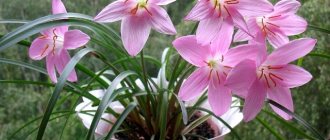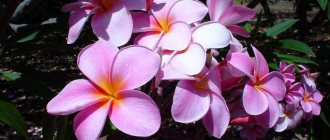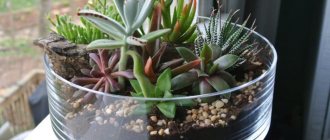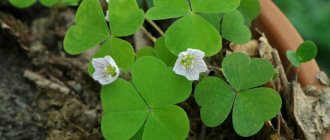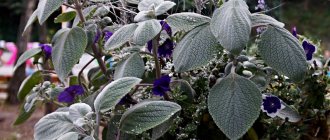It often happens that in an interior decorated with indoor plants, the green color predominates and lacks something bright and extraordinary. In this case, stromanta is exactly what is needed. Spectacular leaves with original colors will certainly attract attention, since the pattern on their surface is striking in its perfection. Stromantha is an undeniably attractive, but very capricious houseplant. However, if you follow special care rules and provide the sissy with suitable conditions, it can delight you for many years, especially since its foliage with an expressive pattern of longitudinal stripes, spots and stains of pink, purple, yellow, cream and vanilla shades is incredibly decorative.
Description and origin
Stromantha is a very spectacular plant
The plant's habitat is damp and swampy areas of South America, Africa and Asia. Tropicana is very moisture- and heat-loving, so growing it “in captivity” is fraught with difficulties.
All plants of the Marantaceae family have very expressive leaves. It is thanks to the brightly colored foliage in the most incredible shades that the flower is highly valued by experienced gardeners.
Close relatives of the plant are ctenantha, arrowroot, calathea, and stromanta is often confused with the latter. The main differences are the structure of the leaf blade and the size of the bush. Calathea leaves are larger (up to 30 cm in length) and have an elongated oval shape. In turn, stromanthus is slightly smaller and, unlike its “relative,” its leaves are slightly pointed and, as a rule, painted in a bright crimson or beetroot shade on the underside.
Stromantha is a herbaceous perennial, reaching a height of 30 cm to 1 m or more. The shape of the chic foliage is elliptical or lanceolate. The plant resembles a half-opened fan formed by painted leaves on long petioles. The top of the leaf blade is decorated with thickened lines of a lighter shade with whitish spots, and the underside and petioles are painted in one of the shades of red (purple, burgundy, beetroot or bright crimson). The flower looks picturesque thanks to the bold combination of different shades.
During the day, the stromanta changes the arrangement of the leaves in the plane several times, lifting them in such a way that the flower suddenly transforms and becomes incredibly elegant. “Getting ready for sleep,” the leaves of this amazing plant begin to rub against each other, making a slight rustling sound. It is for this reason that Stromanta is called the “praying flower” or “pagan prayer.”
Under natural conditions, during the flowering period, Stromanthe appears a long peduncle strewn with small white flowers surrounded by scarlet bracts. However, “in captivity” the plant blooms extremely rarely, so it is unlikely that it will be possible to wait for this event at home.
“In captivity” stromanta blooms extremely rarely
Species diversity
Botanists distinguish 13 species in the genus Stromanthus. But only two of them are most widespread in gardeners’ collections: blood-red and pleasant; it is from these plants that breeders obtain new interesting cultivars, varieties and hybrids.
- Stromanta is nice. The habitat of this species is South America, or more precisely, areas with tropical rainforests. This is a low compact bush up to 25–35 cm in height. The leaves are 15–20 cm long, have a regular oval shape and are colored light green with dark green stripes. The underside of the leaf blades is grayish or silvery-green.
- Stromantha blood red. This species is native to Brazil. The flower is larger than Stromantha pleasanta (adult specimens reach one meter). The leaf blades are pointed and elongated, their upper side is bright green with variegated dark green stripes, and the lower side is purple.
Modern hybridizers have developed several ornamental varieties with bright and expressive foliage. Among them:
- a very impressive variety Triostar (Tricolor), the dark green leaves of which are painted with stripes of cream, salad and pale pink shades, and on the reverse side the leaf blades are burgundy;
- Multicolor - a plant whose leaves are covered with all kinds of stains and spots of light green, cream or white on a dark green background;
- Maroon, the distinctive feature of which is a pronounced vein of a light green hue, located in the center of the bright green leaf blade. The reverse side of the leaf surface is burgundy or purple.
Photo gallery: variety of species and varieties of stromantha
Stromanta multicolor amazes with its original colors
The dark green leaf blades of the Tricolor stromanthus variety are painted with stripes of light green and pale pink shades
Stromantha variety Maroon has a pronounced central vein of a light green hue.
A distinctive feature of this species is the red coloring of the underside of the leaf blade.
Stromantha pleasant - low bush
Stromanta – photo
Stromanta will be an amazing decoration for any interior. It stands out even against the background of taller decorative foliage plants!
Photo: tsveto.ru
Photo: darudar.org
Photo: domashniecvety.ru
Photo: pinterest.com
Photo: rastenievod.com
Photo: stocvetov.ru
Photo: pinterest.ru
Photo: m.nn.ru
Photo: pocvetam.ru
Photo: avekatriina.blogspot.com
Photo: pinterest.ru
Photo: legkovmeste.ru
Photo: lucidincorporated.com
Photo: happymodern.ru
Photo: industry60plus.ru
Photo: pinterest.ru
Photo: loudounballet.org
Photo: cvetyportal.ru
Photo: instagram.com
Photo: youla.ru
Did you like the post? Subscribe to our channel in Yandex.Zen, it really helps us in our development!
Growing conditions - table
The sight of a beautiful and healthy flower brings true aesthetic pleasure. And for this you need to know some of the sissy’s preferences.
| Conditions | Recommendations |
| Temperature | Stromantha prefers warmth. In winter, not lower than 18–20°C, and in summer, not higher than 25°C. It does not tolerate drafts and sudden temperature changes (in such conditions, root rot begins). |
| Lighting | Stromanthe needs good, but diffused lighting (in the shade the color is lost and the leaves become evenly colored). If the light is too intense, stromanthus, on the contrary, acquires a reddish-brown tint, and burns appear on the leaves. In winter, the flower requires additional lighting, which can be provided with fluorescent lamps. |
| Humidity | Loves high humidity (up to 80–90%). This can be achieved by regular spraying or by placing the container with stromanta on damp moss or on a tray of pebbles filled with water. In addition, it is necessary to regularly wipe the leaf blades with a damp sponge. To maintain high humidity, it is also recommended to place the plant in a florarium or grow Stromantha in a bottle garden. |
2. Differences between Stromantha and Calathea
- Stromantha has smaller leaf blades compared to calathea, and the tips of its leaf blades have a pointed shape.
- The leaf petioles are shorter than the leaf blades of Calathea; in Stromantha they are longer than or equal to the length of the leaf blade.
- Calathea leaves do not have red and burgundy tones in their color , while the leaf blades of Stromantha often have a burgundy color on the underside.
- Calathea is large in size and its bushes are distinguished by their spreading shape , while stromanta is distinguished by its more modest size and dense bush shape.
↑ Up,
Features of planting and transplanting
Replant young Stromantha annually. If you are not going to divide, then it is better to transfer the flower from the old container to a larger one, lightly shaking off the soil. Spread the roots from below a little and plant the stromanta in a pre-steamed soil mixture, without deepening the root collar or compacting the substrate too much.
Spring is the best time for the procedure. There is no need to disturb adult plants often, so replant them every 3 years if the container becomes too crowded and the roots appear from the drainage holes. The rest of the time, it is enough to occasionally replace the top layer of soil in the container. To do this, remove the old soil to a depth of about 3 cm, cover it with fresh substrate and lightly moisten it.
If you need to replant a stromanta purchased in a store, first inspect the flower for pests and rinse the foliage well under a warm shower. Then remove from the container and immerse in a solution of any biostimulant. The drugs Epin and Zircon have a good effect. Replant plants purchased in winter, autumn or summer using the transshipment method, being careful not to injure the delicate roots.
Young specimens require annual replanting
Preparing the substrate
Stromanthe needs a loose nutritious soil mixture, it should be light and high in organic matter. Prepare it from leaf soil (the top layer from under the birch tree), peat, and humus. Use all ingredients in equal proportions. Add a little sand to the soil (1/2 part is enough) and charcoal, which will absorb excess moisture in the substrate and return it when the soil dries out. Thus, you will have an air- and moisture-permeable mixture suitable for good growth of capricious stromanthus.
For greater moisture capacity and looseness, some gardeners recommend adding pieces of sphagnum moss.
The soil mixture must be disinfected before use. This is done in two ways: by steaming the substrate or scalding with boiling water. The first method is the most effective. Place the soil in a colander, previously lined with gauze, cover the container with a lid and place it on a saucepan in which water is boiling. Keep in a water bath for 15 minutes and sprinkle the steamed substrate to dry on a sheet of newspaper. When using the second method, each component must be doused with boiling water until completely soaked. After this, the soil should be sprinkled in a thin layer on a sheet of paper, lightly dried in air and the ingredients recombined.
For planting and replanting stromanthas, you can buy soil for arrowroots in a specialized store. Palma substrate is also suitable, but you need to add a little peat soil to it.
Stromanthe requires a loose nutrient substrate
Selecting a container
The container for planting stromanthus needs to be wide and not very deep (its shoots grow wide and the flower will quickly fill the entire surface of the earth in the container). When transplanting into a larger pot, stick to the basic rule, choosing a maximum of 2–2.5 cm larger than the previous one.
The container needs to be shallow and wide
Planting and transplanting - step-by-step description
- Although Stromantha loves high humidity, excess water should not stagnate in the pot. To remove it, you need good drainage. To do this, place a layer of expanded clay, gravel or broken brick at the bottom of the container, add coarse sand on top, which will fill all the voids and prevent soil from washing out.
- Place the substrate on the drainage layer so that there is approximately 1–2 cm between the roots of the stromanthus and the stones. Lightly moisten the soil.
Place a layer of expanded clay, gravel or broken brick at the bottom of the container - Moisten the soil in an old container with stromanta well, crimp the pot and remove the plant.
- Shake off the substrate and carefully rinse the roots under the tap. Cut off damaged ones.
Shake off the substrate and carefully rinse the roots with warm water - Place the stromanta in a new container and spread the roots on a moistened substrate.
- Carefully fill any voids with soil without compacting it. Water the substrate. When the soil settles, add more soil.
- Observe the condition of the transplanted plant for two to three days. If the stromanta is not feeling well, the leaves are drooping, the color has faded, then spray it and put it in a plastic bag. In such a mini-greenhouse, the flower should take root faster.
Home care
Watering and spraying
Stromanthe requires quite abundant watering during the active growth of green mass in spring and summer, and in the autumn-winter period it should be halved (excessive moisture at low temperatures will lead to root rot). It is very important to prevent the earthen ball from drying out or becoming waterlogged, since both drought and excess moisture have a detrimental effect on the flower.
The condition of the soil should be monitored daily. When the top layer of the substrate dries only 1 cm, the stromanthus must be watered with warm, settled water.
Any water (spring, melt, rain or drinking from the tap) must be allowed to settle for several hours. As a result, some of the salts will precipitate, while the water will be saturated with oxygen and become softer. Thus, the soil will become less alkalized and the stromanta will become less capricious and will thank you with a bright appearance. Experienced gardeners recommend standing water in an open container with a wide top so that the chlorine evaporates from it.
It is not advisable to leave water for irrigation for more than two days, as it may begin to deteriorate.
Stromantha should be sprayed daily, and on hot summer days this should be done at least twice a day, since humidity is a vital condition for the flower. Please note that you should not spray the plant during the day, as it can get sunburned .
Fertilizing: how and with what to fertilize a flower depending on the season?
During the period from April to August, fertilize with liquid complex fertilizer for decorative deciduous plants once every 2 weeks. Bona Forte or Fertika preparations, which contain all the macro- and microelements required by the flower in an optimal ratio, have a good effect.
Dilute the fertilizer in accordance with the manufacturer's recommendations. Before fertilizing, moisten the soil, and after a few hours, water it with a nutrient solution. From time to time, you can arrange foliar feeding, for which you need to dilute the fertilizer in half the dose and spray it on the leaves from a spray bottle.
It is recommended to alternate fertilizing with minerals and organic ones. You can use ready-made liquid fertilizer - humate or make an infusion of mullein (it must be filled with water and allowed to ferment for a week). Then the concentrate should be diluted in a ratio of 1:10 and one or two tablespoons of the solution should be added to the substrate (depending on the size of the container). In winter, feeding should be stopped completely.
After transplanting into fresh nutrient soil, Stromanthe does not require feeding for 1 or 1.5 months.
Stromantha at home - video
general information
Stromantha is a compact deciduous plant with a maximum height of 60-80 cm, depending on the variety. Its close relatives are arrowroot and calathea, due to which the plants have a lot in common both in appearance and in the specifics of care.
In nature, stromantha is found in certain regions of America, and there it is even larger and more spectacular. The green leaves are randomly covered with white, cream and pink stripes. Because of this, they look very unusual and elegant.
Stromantha leaves always follow the sun and rise upward towards nightfall. This is a normal phenomenon, because of which the flower was even nicknamed the praying flower. By the way, in nature, stromanta is capable of producing long arrows with buds, but this cannot be achieved at home.
Photo: dom-florista.ru
Table: care problems
| Errors | Probable Causes | Correcting the situation |
| The tips of the leaf blades turn yellowish-brown | Excess or lack of nutrients in the soil. |
|
| The leaves become covered with brown spots and then curl into a tube. | The soil is dry. | The soil must be constantly moist. Adjust the watering regime, do not allow the substrate to dry out completely. |
| The leaves lose color and then dry out | Too intense lighting. | Move the container with stromanta to a place with diffused light. The best option would be an east window. |
| Stems become limp | The temperature of keeping stromanthus is lower than recommended, especially in high humidity. | Increase the temperature of the plant. |
| Leaves fall | Dry indoor air. |
|
Beneficial features
Photo of stromanthus in a pot
The plant is necessary for those who suffer from insomnia. It calms the nervous system before bed, relieves stress and fatigue. There is also an opinion that stromantha helps to gain self-confidence, inspires optimism, lifts the mood and gives additional vital energy.
Table: pests and diseases
| Name | Signs of defeat | Treatment | Prevention of infection |
| Scale insect (shield aphid) | Brown tubercles appear on the leaf blades and stems of stromanthus. The leaves lose their usual color, become limp, pale, then completely dry out and fall off. |
| Periodically check the plants located next to the stromanthus; if shield aphids appear on them, isolate them. |
| Trips | There are light dots on the leaf blades. Then the leaves acquire a silvery sheen. | Spray stromanta with insecticides. For example, Inta-vir, Fitoverm, Decis or Actellik. | Thrips appear on stromanthus at low temperatures and high humidity indoors. Adjust the temperature. Mist the plants as often as possible and install an electric humidifier to maintain the level required by Stromanthe. |
| Red spider mite | The leaf blades become pale yellow in color and white spots form on their surface. Severely affected plants shed their leaves. | Spray with a solution of one of the preparations: Fitoverm, Fufan, Vermitek or Actellik. | Dry indoor air contributes to infection by this pest. Spray stromanta regularly and install an electric humidifier or indoor fountain next to the flower. |
| Root rot (fusarium) | The stems become limp, the tops of the shoots droop. | Stromantha cannot be saved; it dies as a result of infection with fusarium. | Grow the flower at a temperature of at least 20 degrees and maintain high humidity. Treat the flower with a copper-containing preparation twice during the summer. |
Photo gallery: how to recognize pests and diseases
Under the brown tubercles hides an insidious enemy - the scale insect
Thrips colony on a plant leaf
A thin cobweb that appears on a leaf is a sign of the appearance of a red spider mite
Low temperatures and frequent waterlogging of the soil are the cause of root rot.
Stromantha leaves become stained due to insufficient watering and as a result of burns
Possible difficulties during cultivation
Stromantha leaves dry out
This is the most common problem when growing a plant. There are different reasons. But the most typical one is too dry air. To avoid this problem, spray the stromanta more often. If it is not possible to carry out frequent spraying, place the pot in a tray with damp moss or expanded clay, and place a container of water next to it.
The second reason that stromanthus leaves dry out may be damage by spider mites. Moreover, this is a direct connection with the first reason, that is, dry air. Such conditions are an ideal environment for its appearance. Examine your plant carefully. It is advisable to arm yourself with a magnifying glass. If you notice that there is a very thin web on the stromanthus, then this is a sure sign of a spider mite. Upon closer inspection, you can see the pest itself. The first step is to spray the plant or wipe the leaves with a sponge dipped in soapy water. You should use regular laundry soap. After this, put a plastic bag on the plant and keep the plant like that for 4-5 hours. After this, remove the bag and rinse off the soap under a warm shower. After a while, check the stromantha leaves again, after 5 days. If the pest has not disappeared, you can try a stronger remedy. For example, Aktelik helps a lot.
Leaves can also dry out as a result of sunburn. This is preceded by discoloration of the leaf plate.
Stromantha leaves curl
This is a clear sign of improper, disordered watering. If they simply curl up into a tube, then most likely this is a consequence of a lack of moisture in the soil; it is too dry. Too low a temperature may also be the cause.
Stromantha leaves fall
If, in addition to this, the petioles of the leaves also wither, the stem weakens and withers, then this is a clear sign of waterlogging of the soil. In the warm season, this is a rare occurrence. But in winter, waterlogging coupled with low air temperatures, especially if the pot is on a cold windowsill, this happens often. A complete stromantha transplant should be performed immediately. That is, replace all the soil with fresh one. At the same time, examine the root system, remove damaged roots, and treat the roots with a fungicide. If everything is done on time, the plant can be saved. Otherwise, the plant will die.
There is a yellow-brown border or spots along the edges of the leaves
The result of an unbalanced diet. Such spots on the edges of the stromanthus leaf blade appear as a result of either a lack of nutrients or, most likely, an excess of them. The plant is overfed. Fertilizers with a high calcium content cause a particularly negative reaction from stromanthus.
Reproduction
Stromantha reproduces quite easily. Over the course of a season, it grows a large number of shoots and can be divided by combining the transplantation procedure with flower propagation. For the divisions, you should choose low, wide and rounded at the bottom bowls, in the bottom of which there are drainage holes. Stromantha also reproduces well through apical cuttings, which quickly take root.
Dividing the rhizome - step-by-step instructions
- Remove the stromanthus bush from the old pot, shake off the soil and rinse the roots under the tap.
- Divide the flower into several parts: it is optimal if there are two or three sections. Powder the rhizome sections with charcoal. Plant each bush in separate small containers with a slightly moist substrate.
- Give new Stromantha specimens time to adapt. Start watering only when the soil is completely dry.
- At the beginning of rooting the divisions, you can cover each plant with a transparent cap (for example, a plastic bottle cut in half) to create greenhouse conditions for new plants. After a week, the cap can be removed.
Dividing the stromantha bush is combined with
Rooting cuttings - step-by-step instructions
- Cut the cuttings so that they have two or three leaf blades (the length of the planting material should be approximately 7–10 cm). Please note that the cut should pass below the attachment of the leaf to the stem.
- Place the prepared cuttings in a container with water and cover with a transparent plastic bag.
- In about a month, roots will grow on the cuttings. Plant rooted planting material in bowls with a slightly acidic soil mixture based on peat with the addition of leaf soil, coarse sand, vermiculite or perlite.
- After two months, young stromanthus can be transplanted into a flower pot in which they will grow continuously.
Reviews from flower growers about growing Stromantha
I’ve been dreaming about this plant for a long time! And I finally bought it.
But when I brought it home, I was surprised that the price tag said calathea (similar, but still a different plant). I gave it a week to get used to the new conditions, and only then I transplanted it! I placed it on a windowsill with direct sunlight during the lunch and morning hours. Somehow I don’t take special care of it, it likes watering and spraying, and also takes a shower once every two weeks))))) The photo was taken right after the purchase, now it has grown ugh ugh! I love it, I advise you to buy it))) anastasia z
https://irecommend.ru/content/moya-krasotkafoto
If you are an esthete and love truly living plants, with a very graceful appearance, then you can certainly cast in your lot with this miracle flower.
Why do I say a miracle, because its folding and unfolding leaves form a person’s perception of it as if it were alive. With all this, it has a charming color of the leaves, and looking at them, you really feel exotic; after all, you won’t see such flowers in our post-Soviet space. However, in order for these flowers to be in such an attractive guise, you need to protect this flower like the apple of your eye from external irritants. In particular, you need to eliminate all drafts; I personally had to install double-glazed windows in the apartment for this. In addition, like Ichthyander, he needs to breathe, so spray moisture over him several times a day. During the summer heat, it needs more water, as in principle almost all flowers, so water more often. The main thing is to place it on the south side of the room, it will be better in any case since there will be more light there in any case. Remember that this sophisticated flower will immediately let you know if something is wrong. Its leaves will simply begin to curl and become damp. If this suddenly happens, it is necessary to work on mistakes and eliminate traumatic factors. Moreno
https://otzyv.pro/reviews/otzyvy-stromanta-109715.html
This beauty was given to me by my mother, knowing its name, but without reading anything about it, I just put it on the windowsill, sprayed and watered it, but no such luck).
Stromantha began to dry out the leaves, I increased the spraying, but it did not help. And then I decided to study it. Stromantha loves light, but it needs to be protected from direct rays. I moved it to the east window, but shaded it with newspaper in the summer. She loves watering, especially in summer and autumn; if you move it to a cooler room, then reduce it. I didn’t have any coolness for it, I stayed in the room for the winter, and it was very hot there, I watered it the same way as in the summer. Feed in summer - once every 2 weeks, in winter - do not fertilize, because is at rest. And don’t pour water on it, spray it more often. Svetka-1502
https://spasibovsem.ru/responses/kaprizna-no-ono-togo-stoit.html
If you want to tickle your nerves, you can get a stromanta.
I started it for the stunningly beautiful leaves, but then I regretted it. I’ll say right away that often the beautiful multi-colored leaves of stromanthus can turn into just green at home. This is due to the fact that variegated plants need a lot of light! But not everyone in their apartments can meet this condition. The funny thing is that there is a lot of light on the southern windows, but you can’t put stromanta there - the leaves won’t withstand direct sunlight! And with a lack of light, the stromanta begins to go bald very quickly. In addition, with all this, this plant grows well at a temperature of 28 degrees! Where can you get such conditions in an apartment? Well, if we go further, then an unexpected draft can destroy the stromanta, and the watering is not the same. In general, she is beautiful, but the treatment did not suit me personally at all. Murmur
https://spasibovsem.ru/responses/ne-bylo-pechali-kupila-baba-porosya.html
Questions and answers
- What is the difference between calathea and stromantha?
Quite often these plants are confused, as they are very similar. They differ in inflorescences. Calathea flowers have a basket shape. Unlike Stromantha, the lower part of the leaf does not have a beetroot or cherry tint.
- Is it possible to keep Stromanta in the house?
The signs and superstitions attributed to Stromante often make flower growers think about whether this flower is worth buying. The plant brings financial and family well-being to the home. Its mystical positive influence is especially manifested where a young married couple lives. If we take into account the positive signs of stromanta and its beautiful appearance, then it is perfect for apartments and houses where people of several generations live.
- If stromantha has bloomed, how long can you go without cutting off the peduncle?
At home, stromanta practically does not bloom. If she has a peduncle, then you shouldn’t enjoy such a rare sight. It must be removed immediately, as the plant tolerates flowering painfully. The leaves of the flower turn pale, the bush stops growing and thins out. Stromanta will take a long time to leave. Flowering has a very negative effect on this plant.
Rate this post



